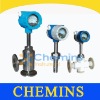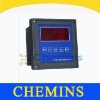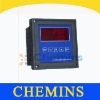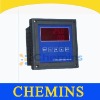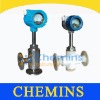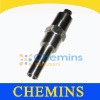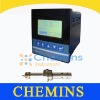- Flow Meters[7]
- PH Meters[10]
- Other Analysis Instruments[10]
- Concentration Meters[10]
- Level Measuring Instruments[10]
- Gas Analyzers[7]
- Contact Person : Mr. Gong Jack
- Company Name : Yantai Chemins Instrument Co., Ltd.
- Tel : 86-535-8381357
- Fax : 86-535-8381357
- Address : Shandong,Yantai,No.68, Puzhao road, Zhaoyuan, Shandong, China
- Country/Region : China
- Zip : 265400
DDM industrial transmitter (conductivity apparatus)
DDM series conductivity transmitter
Overview DDM series industry conductivity transmitters is a kind of process meter which measure ion concentration by indirectly measuring the conductivity of the solution. It can work on line to measure the aqueous solution’s conductivity in industrial processes. Conductivity is an important indicator of water purity. The amount of impurities of boiler water, semiconductor industrial used demonized water, distilled water and in industrial wastewater, is measured by conductivity. The concentration of acids, alkali and salt solution in various chemical liquid, and the dissolved oxygen in boiler water can all be measured by conductivity.
Technical parameter
Measurement scale | 0-10 ~ 0-50,000μs/cm |
Accuracy | 1.5 class |
Drift | ≤ 0.5% / 24 Hour |
Load characteristics | 0 ~ 600Ω for 4 ~ 20mA |
170 ~ 250VAC | |
0 ~ 1200Ω for 0 ~ 10mA | |
Operating pressure | 0.6MPa or 2.5MPa |
Medium temperature | -10 ~ 80°C, 80 ~ 180°C |
Environmental conditions | Ambient temperature: -10 ~ 55 °C |
Humidity: ≤ 95% |
Working principle
1. The concept of conductance and conductivity
Electrolyte solution is like the metal conductor, is a good conductor for electricity. Therefore, current flows through the electrolyte, there must be resistance effect, and in accordance with Ohm's law. However, the resistance temperature characteristics of liquid is contrast with metal conductor, it’s temperature characteristic is negative. As distinguished from the metal conductor, the conductance of electrolyte solution is expressed by the reciprocal of the resistance, and the conductivity is the reciprocal of the resistivity. If G represent conductance, S represent conductivity, then there is the following formula:
Where:
R - Liquid resistance, Ω.
ρ - Resistivity, Ω · cm.
L - Distance between plate of the electrode, cm.
A - Electrode plate’s cross-sectional area, cm2.
G - Conductance, S (Siemens, 1S = 1Ω-1).
S - Conductivity, S · cm-1 or (Ω · cm)-1
k - Electrode constant, cm-1.
When L = 1cm and A = 1cm2, G = S. Means that 1 cm3 volume of the solution’s conductance is conductivity. If fill 1 molar’s solution in the 1 cm3 volume, then it’s called molar conductivity.
2. The conductivity measurement
Two mutually insulated electrode formed the conductivity cell, in which, fill with target medium. Pass through alternating current with constant voltage, to form the electrical circuit. Fixed voltage and electrode size, the loop current I is a function of the conductivity:
I0 = f (s) = K · S + d
Where K is the slope of linear equation, and related with power supply parameter of the conductivity cell. Change the power supply parameters, you can change the slope (measuring range). Linear equation fixed the range of output current, so when S = 0, the constant d can be calculated, which can determine the current value that flowing through the target medium. So the conductivity can be measured by current. See figure below.
In the electrolyte solution, the larger of the ion concentration per unit volume, the greater of the conductivity; The higher of the valence of ions, the greater of the conductivity; The faster of the ion mobility, the greater of the conductivity. The conductivity of the absolutely pure water is 5.5 × 10-8 S/cm (25°C). The relationship of conductivity for different aqueous solution is as follows:
DDM industrial transmitter (conductivity apparatus)

